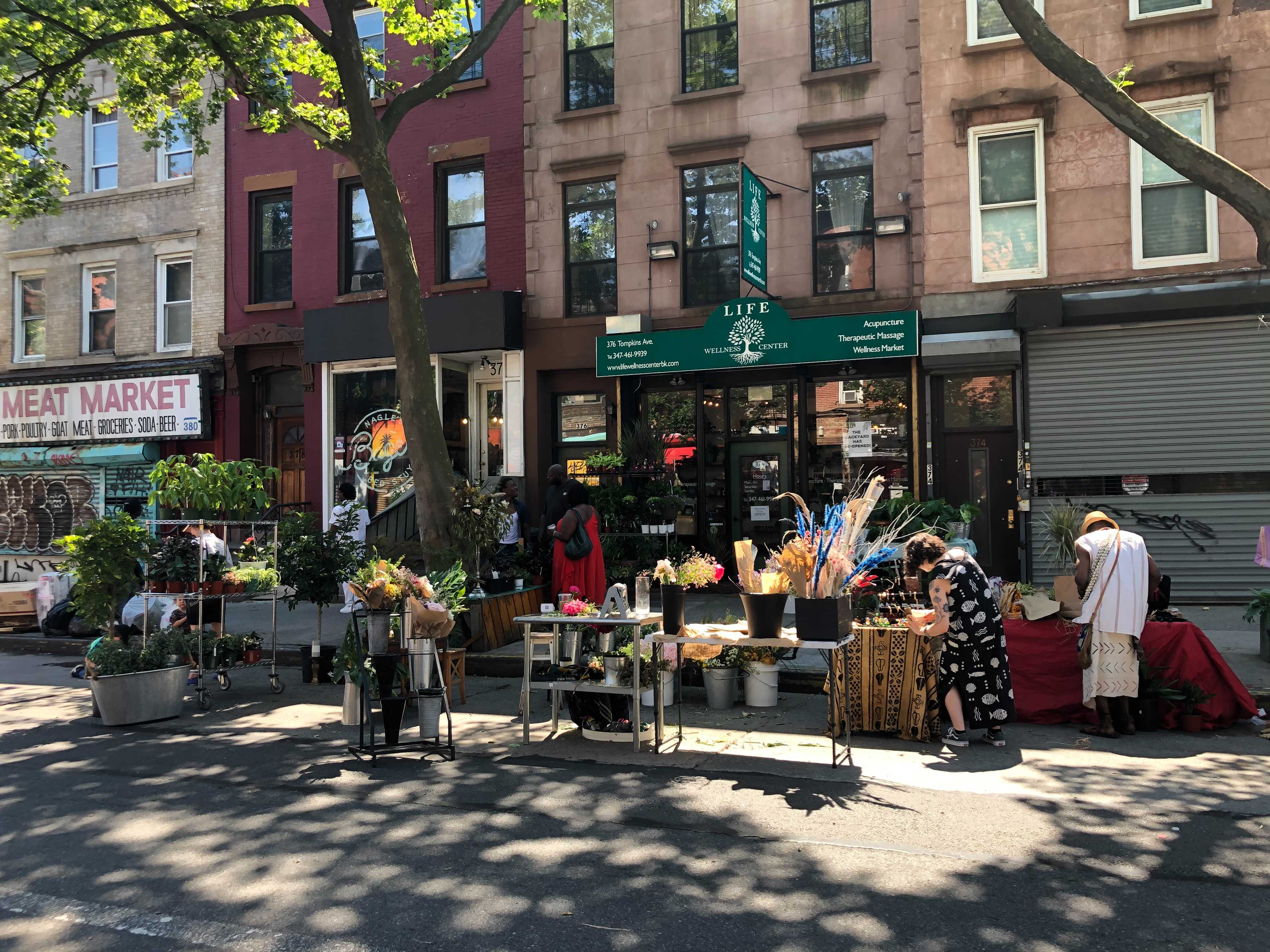[ RECOMMENDATION ]
15. Make Open
Storefronts a permanent City program.
WHYCustomer attention
is often short-lived—especially now, as customers are being more selective in
how and where they spend their time and their dollars. With the rise of e-commerce and other disruptions now, more than ever,
storefronts and their frontage zones (typically the one-to-two-foot sidewalk
area adjacent to the property line, where transitions between the space within
buildings and the public realm occur) need to be optimized through a mix of
temporary or ad-hoc signage, furniture, and seasonal merchandise displays to
grab a customer’s attention and shape positive first impressions.
The pandemic-era Open Storefronts Permit (zero cost, simple digital application with self-certification capability) enabled the activation of the frontage zone by allowing eligible businesses (retail trade, food service, repair stores, personal care services, and dry-cleaning and laundry services) to conduct activity on sidewalks and was, during the pandemic, an alternative regulation to the Revocable Consent Permit and Stoop Line Stand License.
Although the uptake of the permit, compared with Open Restaurants, was lower (many stakeholders shared that the permit launched late in the pandemic and during the less ideal colder months of 2020), it significantly lowered barriers for businesses that needed to spill out onto the sidewalk to increase visibility and signal that they were open for business.
The Open Storefronts program was eventually expanded to include food service establishments, allowing restaurants to participate in both Open Restaurants and Open Storefronts. The public could now enjoy a sit-down meal along the curb or purchase a grab-and-go item at the sidewalk, embracing our public space as multi-purpose spaces.
The pandemic-era Open Storefronts Permit (zero cost, simple digital application with self-certification capability) enabled the activation of the frontage zone by allowing eligible businesses (retail trade, food service, repair stores, personal care services, and dry-cleaning and laundry services) to conduct activity on sidewalks and was, during the pandemic, an alternative regulation to the Revocable Consent Permit and Stoop Line Stand License.
Although the uptake of the permit, compared with Open Restaurants, was lower (many stakeholders shared that the permit launched late in the pandemic and during the less ideal colder months of 2020), it significantly lowered barriers for businesses that needed to spill out onto the sidewalk to increase visibility and signal that they were open for business.
The Open Storefronts program was eventually expanded to include food service establishments, allowing restaurants to participate in both Open Restaurants and Open Storefronts. The public could now enjoy a sit-down meal along the curb or purchase a grab-and-go item at the sidewalk, embracing our public space as multi-purpose spaces.
GOALS
︎ A User Experience
︎ B Long-Term Coordination
︎ C Inclusive Design
︎ D Collaboration and Communication
︎ E Support commerce and entrepreneurship
CATEGORY / TYPE
︎ Process / Regulatory Framework
︎ Funding
︎ Technical Assistance
︎ A User Experience
︎ B Long-Term Coordination
︎ C Inclusive Design
︎ D Collaboration and Communication
︎ E Support commerce and entrepreneurship
CATEGORY / TYPE
︎ Process / Regulatory Framework
︎ Funding
︎ Technical Assistance
HOW TO IMPLEMENT The proposed Public Realm Working Group should launch a permanent Open Storefronts permit that allows ground floor businesses to expand commercial activity within a prescribed frontage zone. The frontage zone may vary based on sidewalk width in the district but should allow eligible activities such as those allowed in the pandemic: put up temporary signage (e.g. A-frames), display shelves, furniture and goods, seating and ropes/stanchions, conduct promotional activities, complete transactions, sell packaged food and drink, and designate space for outdoor drop off and pick up of customer purchases or take-out operations.
The proposed Public Realm Working Group should also evaluate whether unrelated businesses can occupy the frontage zone with the permission of the indoor business. Encouraging innovative co-location sharing amongst businesses could be helpful in an expensive urban market like New York and would support entrepreneurs starting businesses who find that operating in the public realm is low-cost and perhaps the only viable alternative to leasing out entire storefronts.
Case Study ︎︎︎ Case Study ︎︎︎ Case Study ︎︎︎
Temporary Activation Permit
City of Seattle, WADuring the pandemic,
the City of Seattle streamlined its permitting process for temporary
activations, allowing business applicants to activate its “Temporary Use Areas”
with outdoor merchandise display for a time limited period—up to either four
weeks or six months. The permit application process is fully available online
and requires a site plan, photo or concept image, and certificate of insurance
on the part of the business applicant.

Public Frontage Standards
City of New Rochelle, NY
The City of New
Rochelle has assigned classifications to streets in its downtowns to allow
property owners and business owners to more easily identify the widths of the
sidewalks that are designated as “Public Frontage” or “Transition Zones,” which
may be used for storefront activation and furnishings. This eliminates any
confusion between stakeholders and the Planning Department on what segments of
the sidewalk may be used for transitory activation.
WHO DOES THIS HELP
Retail and non-retail businesses
Retail and non-retail businesses
︎︎︎ Executive Summary
︎︎︎ Introduction
︎︎︎ The Brief/Challenge
︎︎︎ Understanding the Regulatory Landscape
︎︎︎ Sidewalks
︎︎︎ Streets
︎︎︎ Plazas
︎︎︎ Navigating the Current Regulatory Process
︎︎︎ Adapting to the Pandemic
︎︎︎ Introduction
︎︎︎ The Brief/Challenge
︎︎︎ Understanding the Regulatory Landscape
︎︎︎ Sidewalks
︎︎︎ Streets
︎︎︎ Plazas
︎︎︎ Navigating the Current Regulatory Process
︎︎︎ Adapting to the Pandemic
︎︎︎ Enhancing the City’s Approach to Public Space Management
︎︎︎ Recommendations
︎︎︎ Appendix
︎︎︎ Credits
︎︎︎Watkins Public Space
︎︎︎What’s Up, Jamaica!
︎︎︎ Recommendations
︎︎︎ Appendix
︎︎︎ Credits
︎︎︎Watkins Public Space
︎︎︎What’s Up, Jamaica!
